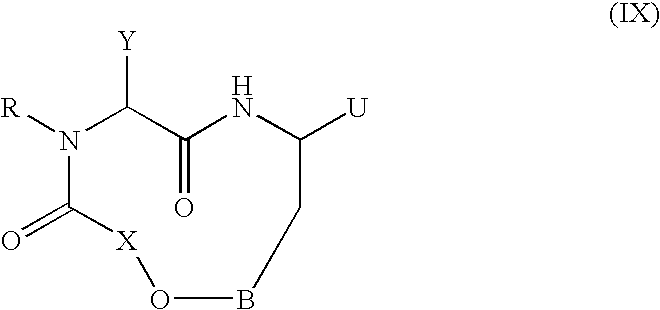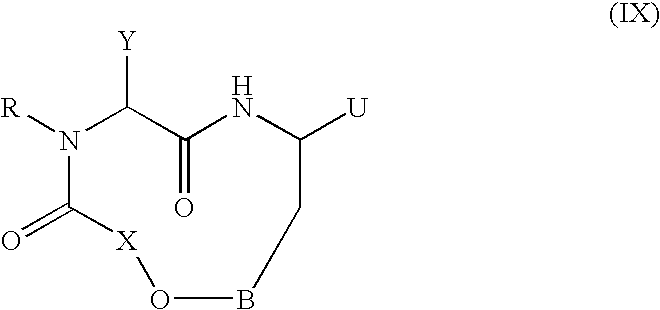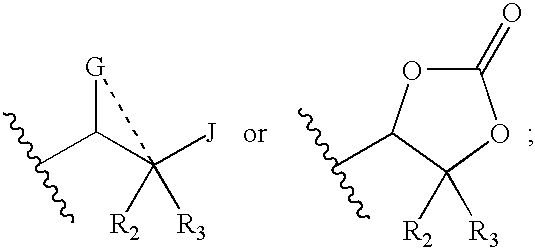Macrocycles useful in the treatment of Alzheimer's disease
a microcycle and alzheimer's disease technology, applied in the field of substituting cyclic amides, can solve the problems of ineffective treatment, severe impairment and eventual death, and no effective treatment for halting, preventing, or reversing the progression of alzheimer's diseas
- Summary
- Abstract
- Description
- Claims
- Application Information
AI Technical Summary
Benefits of technology
Problems solved by technology
Method used
Image
Examples
examples
Synthesis
Example A
12-[2-(3-Ethyl-benzylamino)-1-hydroxy-ethyl]-16-fluoro-2-oxa-8,11-diaza-bicyclo[12.3.1]octadeca-1(17),14(18),15-triene-7,10-dione (1)
Step 1: Preparation of {[1-(3-Benzyloxy-5-fluoro-benzyl)-2,3-dihydroxy-propylcarbamoyl]-methyl}-carbamic acid benzyl ester
[0364]
[0365] To a solution of 3-amino-4-(3-benzyloxy-5-fluoro-phenyl)-butane-1,2-diol (5.60 g, 18.34 mmol, 1.00 eq.), triethylamine (5.11 mL, 36.68 mmol, 2.00 eq.) and anhydrous DMF (100 mL) at 0° C. is added Z-glycine N-succinimidyl ester (6.18 g, 20.17 mmol, 1.10 eq.) with stirring under N2. After 2 hours, the reaction is quenched with 1N HCl, extracted with ethyl acetate, and washed with 10% NaHCO3 and then brine. The organic layer is then dried with MgSO4, filtered through Celite, and concentrated in vacuo, yielding the crude product as a light amber oil. Purification via flash chromatography in 5% MeOH / CHCl3 (rf. 0.33, KMnO4 stain), affords the final product as a white solid (5.40 g., 59% yield overall). ...
example a
[0379] The compounds of the invention are analyzed for inhibitory activity by use of the MBP-C125 assay. This assay determines the relative inhibition of beta-secretase cleavage of a model APP substrate, MBP-C125SW, by the compounds assayed as compared with an untreated control. A detailed description of the assay parameters can be found, for example, in U.S. Pat. No. 5,942,400. Briefly, the substrate is a fusion peptide formed of maltose binding protein (MBP) and the carboxy terminal 125 amino acids of APP-SW, the Swedish mutation. The beta-secretase enzyme is derived from human brain tissue as described in Sinha et. al, 1999, Nature 40:537-540) or recombinantly produced as the full-length enzyme (amino acids 1-501), and can be prepared, for example, from 293 cells expressing the recombinant cDNA, as described in WO00 / 47618.
[0380] Inhibition of the enzyme is analyzed, for example, by immunoassay of the enzyme's cleavage products. One exemplary ELISA uses a...
example b
Cell Free Inhibition Assay Utilizing a Synthetic APP Substrate
[0384] A synthetic APP substrate that can be cleaved by beta-secretase and having N-terminal biotin and made fluorescent by the covalent attachment of Oregon green at the Cys residue is used to assay beta-secretase activity in the presence or absence of the inhibitory compounds of the invention. Substrates include the following:
[SEQ ID NO: 1]Biotin-SEVNL-DAEFRC [oregon green] KK[SEQ ID NO: 2]Biotin-SEVKM-DAEFRC [oregon green] KK[SEQ ID NO: 3]Biotin-GLNIKTEEISEISY-EVEFRC [oregon green] KK[SEQ ID NO: 4]Biotin-ADRGLTTRPGSGLTNIKTEEISEVNL-DAEFRC[oregon green] KK[SEQ ID NO: 5]Biotin-FVNQHLCoxGSHLVEALY-LVCoxGERGFFYTPKAC[oregon green] KK
[0385] The enzyme (0.1 nanomolar) and test compounds (0.001-100 micromolar) are incubated in pre-blocked, low affinity, black plates (384 well) at 37 degrees C. for 30 minutes. The reaction is initiated by addition of 150 millimolar substrate to a final volume of 30 microliter per well. The fi...
PUM
| Property | Measurement | Unit |
|---|---|---|
| pH | aaaaa | aaaaa |
| pH | aaaaa | aaaaa |
| pH | aaaaa | aaaaa |
Abstract
Description
Claims
Application Information
 Login to View More
Login to View More - R&D
- Intellectual Property
- Life Sciences
- Materials
- Tech Scout
- Unparalleled Data Quality
- Higher Quality Content
- 60% Fewer Hallucinations
Browse by: Latest US Patents, China's latest patents, Technical Efficacy Thesaurus, Application Domain, Technology Topic, Popular Technical Reports.
© 2025 PatSnap. All rights reserved.Legal|Privacy policy|Modern Slavery Act Transparency Statement|Sitemap|About US| Contact US: help@patsnap.com



